AMD’s 5 GHz Turbo CPU in Retail: The FX-9590 and ASRock 990FX Extreme9 Review
by Ian Cutress on August 9, 2014 8:00 AM ESTGaming Benchmarks
F1 2013
First up is F1 2013 by Codemasters. I am a big Formula 1 fan in my spare time, and nothing makes me happier than carving up the field in a Caterham, waving to the Red Bulls as I drive by (because I play on easy and take shortcuts). F1 2013 uses the EGO Engine, and like other Codemasters games ends up being very playable on old hardware quite easily. In order to beef up the benchmark a bit, we devised the following scenario for the benchmark mode: one lap of Spa-Francorchamps in the heavy wet, the benchmark follows Jenson Button in the McLaren who starts on the grid in 22nd place, with the field made up of 11 Williams cars, 5 Marussia and 5 Caterham in that order. This puts emphasis on the CPU to handle the AI in the wet, and allows for a good amount of overtaking during the automated benchmark. We test at 1920x1080 on Ultra graphical settings.
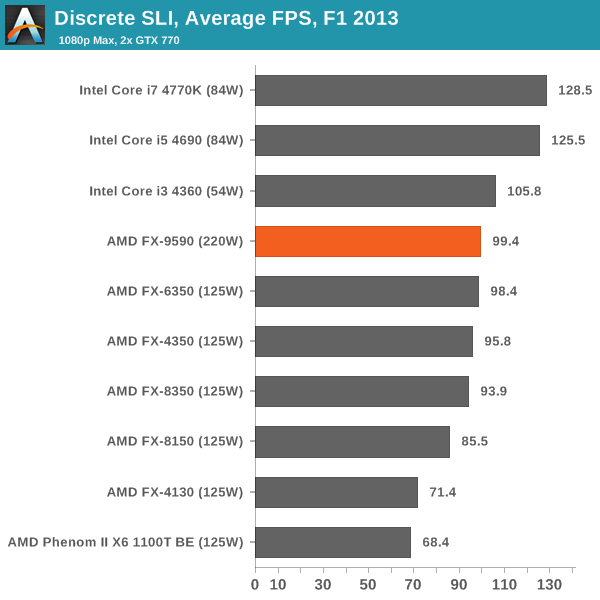
The FX-9590 seems to match the i3-4360, indicating that even more cores, more frequency and more PCIe lanes is not always a good thing. The i3-4360 is using PCIe 3.0 x8/x8, compared to PCIe 2.0 x16/x16 for the FX-9590, which should put them both equal in bandwidth.
Bioshock Infinite
Bioshock Infinite was Zero Punctuation’s Game of the Year for 2013, uses the Unreal Engine 3, and is designed to scale with both cores and graphical prowess. We test the benchmark using the Adrenaline benchmark tool and the Xtreme (1920x1080, Maximum) performance setting, noting down the average frame rates and the minimum frame rates.
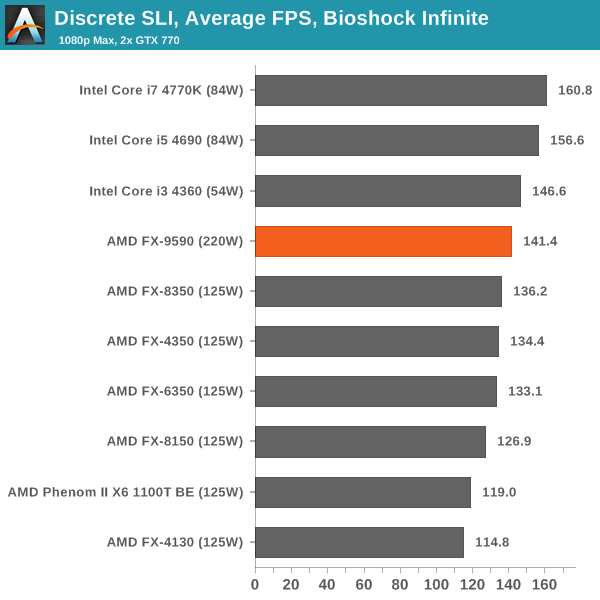
Again, the FX-9590 is trading around the Haswell i3 margin.
Tomb Raider
The next benchmark in our test is Tomb Raider. Tomb Raider is an AMD optimized game, lauded for its use of TressFX creating dynamic hair to increase the immersion in game. Tomb Raider uses a modified version of the Crystal Engine, and enjoys raw horsepower. We test the benchmark using the Adrenaline benchmark tool and the Xtreme (1920x1080, Maximum) performance setting, noting down the average frame rates and the minimum frame rates.
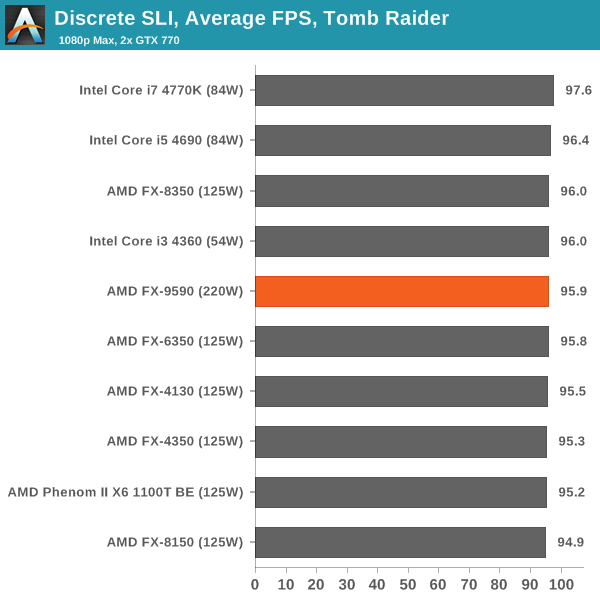
Tomb Raider has historically been CPU agnostic, with all the latest CPUs performing similarly.
Sleeping Dogs
Sleeping Dogs is a benchmarking wet dream – a highly complex benchmark that can bring the toughest setup and high resolutions down into single figures. Having an extreme SSAO setting can do that, but at the right settings Sleeping Dogs is highly playable and enjoyable. We run the basic benchmark program laid out in the Adrenaline benchmark tool, and the Xtreme (1920x1080, Maximum) performance setting, noting down the average frame rates and the minimum frame rates.
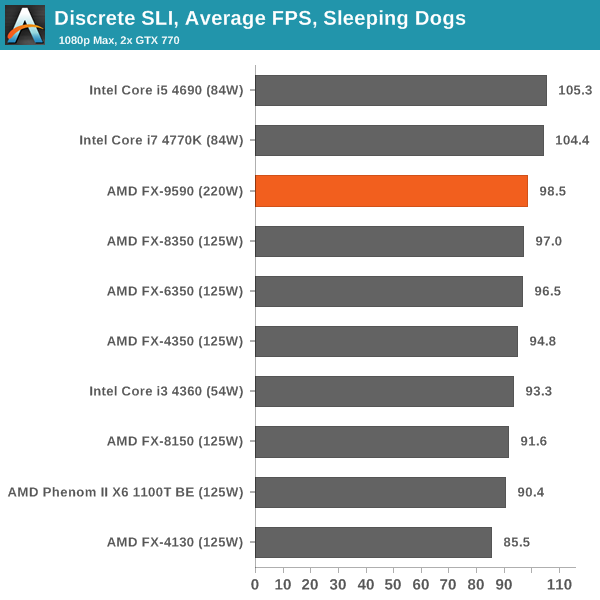
The FX-9590 loses 4-6 FPS on average to the latest Intel cohort, which is not bad considering the release date difference.
Company of Heroes 2
Company of Heroes 2 also can bring a top end GPU to its knees, even at very basic benchmark settings. To get an average 30 FPS using a normal GPU is a challenge, let alone a minimum frame rate of 30 FPS. For this benchmark I use modified versions of Ryan’s batch files at 1920x1080 on High. COH2 is a little odd in that it does not scale with more GPUs with the drivers we use.
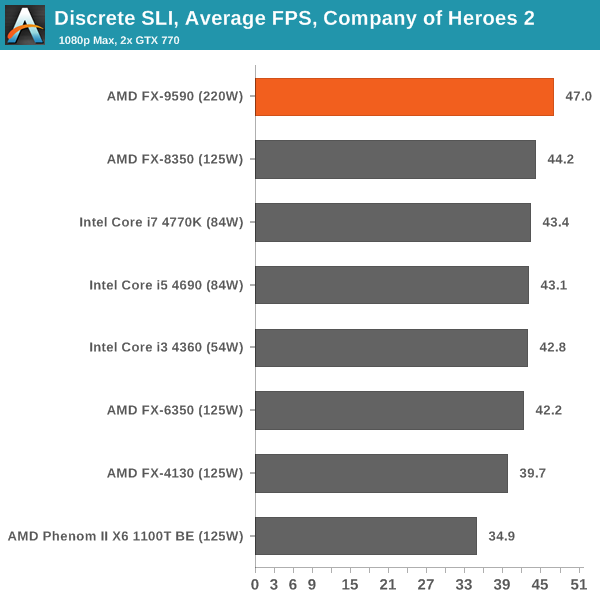
Company of Heroes 2 is usually relatively CPU agnostic except for the older dual core CPUs, but the FX-9590 gets a win here.
Battlefield 4
The EA/DICE series that has taken countless hours of my life away is back for another iteration, using the Frostbite 3 engine. AMD is also piling its resources into BF4 with the new Mantle API for developers, designed to cut the time required for the CPU to dispatch commands to the graphical sub-system. For our test we use the in-game benchmarking tools and record the frame time for the first ~70 seconds of the Tashgar single player mission, which is an on-rails generation of and rendering of objects and textures. We test at 1920x1080 at Ultra settings.
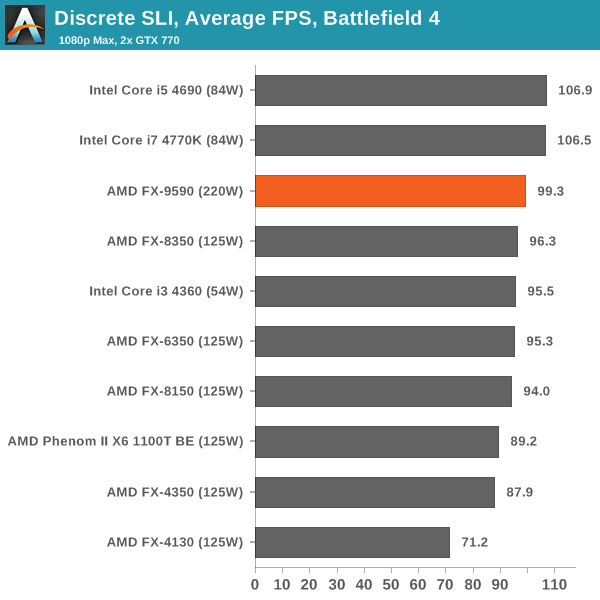
Similar to Sleeping Dogs, the FX-9590 does not lose much considering the release date difference of the architectures.






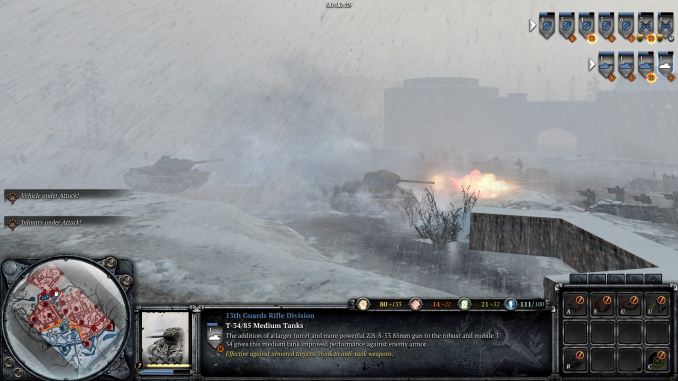









146 Comments
View All Comments
TiGr1982 - Saturday, August 9, 2014 - link
No, no FX in the future - at least, not on Bulldozer-derived microarchitectures.Just APUs till 2016 at least.
will1956 - Saturday, August 9, 2014 - link
i've gotten the sabertooth 990FX GEN3 R2.0 and its got pcie 3 x16 with a 8350 and a sapphire 7870 ghz (both OC'ed) and its pretty good although rather greedyTiGr1982 - Saturday, August 9, 2014 - link
It's nice that this kind of boards exist, but, sadly, PCI Express 3.0 is a rarity rather than a norm on AM3+.AMD only has PCI Express 3.0 as a standard on FM2+ with Kaveri APU.
roadapathy - Saturday, August 9, 2014 - link
I see by the comments below that I'm among the rational. AMD is stuck on the 32nm fab process making for a dismal performance experience for us all! My AMD 6-core could boil water. This is great for the cold midwestern American climate but the Summer is unbearable with AMD CPUs. I had waited over 2 years for a 22nm AMD 8 core FX that never appeared. Meanwhile, I'm running the "lower" 95watt CPU. I can't even imagine how it would be with the 220watt. How ridiculous!!RussianSensation - Sunday, August 10, 2014 - link
Exactly!! Someone understands. If AMD could move to 14nm, they could increase the number of modules 50%-100% and lower the power usage at the same time. When you CPU is on 32nm while Intel is soon to launch 14nm Broadwell, the chance of AMD competing in performance or performance/watt is 0%.Death666Angel - Sunday, August 10, 2014 - link
But more cores aren't really the issue for AMD, are they? In multi-threaded stuff they are already doing fine. What they need is better IPC. Even at 5GHz they barely beat i3s of the current generation. Unfortunately the FX-9590 isn't in bench yet, but the FX-8350 even loses to a chip on 32nm (i5-2500k) in most benchmarks except some multi threaded ones. Put an i7-2600k in its place and it loses even more consistently. That is not just a lithography disadvantage, that is a straight up embarrassment from the CPU architecture standpoint. And the fact that they aren't releasing any more FX CPUs based on newer architectures is a slap in the face of any PC enthusiast.TiGr1982 - Monday, August 11, 2014 - link
Indeed; placed my response too.Budburnicus - Wednesday, January 14, 2015 - link
exactly! AMD has HORRIBLE IPC which results in horrible efficiency - ALSO bear in mind that the 3 year old i5 and i7 parts are 32nm fab, and are 95 watt TDP parts - which can easily be clocked at 4.7 Ghz and totally SPANK this CPU in every way!AMD need a totally new architecture to go with a new fabrication, otherwise it will remain meaningless and eat more power. IPC is incredibly important - just because this FX 9590 is much newer than an i7-2600K and therefore has more and newer instruction sets, does NOT mean it performs better! It performs far worse in fact - whilst eating more power - using the same fab size!
TiGr1982 - Monday, August 11, 2014 - link
It's not the manufacturing tech itself - their Bulldozer-derived microarchitecture has drastically slower IPC (Instructions Per Clock). If you you emphasize lithography, then let's compare FX Piledriver from late 2012 on GF 32 nm lithography and Sandy Bridge LGA1155 Core i7 from early 2011 on Intel's 32 nm lithography.Guess what? Sandy Bridge is around 50% faster in single threaded tasks than Pilderiver. At the "same" lithography. Despite the fact that Sandy Bridge i7 has just 9 MB L2+L3 cache, while Piledriver has 16 MB L2+L3 cache. So, AMD's chip has almost twice the amount of cache than Intel's chip and is still 50% slower. So, first, the case with AMD FX is mainly a problem of inappropriate microarchitecture, and only then comes the lithography lag.
So, even if a Cinderella's fairy comes up and magically moves FX Piledriver to Intel's 22 nm or even 14 nm, the resulting tiny Piledriver shrink will still be a Slowpoke in single thread duties - because it is its microarchitecture that prevents it from doing better.
roadapathy - Monday, August 11, 2014 - link
I don't have a complaint about the architecture itself because of the price points. Intel CPU, motherboard and the RAM are all much more expensive! I'd be satisfied with AMD FX series (or the new Kavari) on the 20nm fab process.